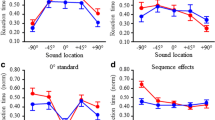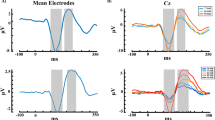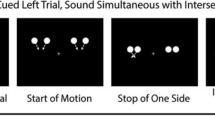Abstract
Behavioral research indicates that healthy aging is accompanied by maintenance of voluntary attentional function in many situations, suggesting older adults are able to use attention to enhance and suppress neural activity. However, other experiments show increased distractibility with age, suggesting a failure of attention. One hypothesis for these apparently conflicting findings is that older adults experience a greater sensory processing load at baseline compared to younger adults. In this situation, older adults might successfully modulate sensory cortical activity relative to a baseline referent condition, but the increased baseline load results in more activity than younger adults after attentional modulation. This hypothesis was tested by comparing average functional brain activity in auditory cortex using quantitative perfusion imaging during resting state and steady-state visual conditions. It was observed that older adults demonstrated greater processing of task-irrelevant auditory background noise than younger adults in both conditions. As expected, auditory activity was attenuated relative to rest during a visually engaging task for both older and younger participants. However, older adults continued to show greater auditory processing than their younger counterparts even after this task modulation. Furthermore, auditory activity during the visual task was predictive of cross-sensory distraction on a behavioral task in older adults. Together, these findings suggest that older adults are more distractible than younger, and the cause of this increased distractibility may lie in baseline brain functioning.





Similar content being viewed by others
References
Alain C, Woods DL (1999) Age-related changes in processing auditory stimuli during visual attention: evidence for deficits in inhibitory control and sensory memory. Psychol Aging 14:507–519
Andres P, Parmentier FB, Escera C (2006) The effect of age on involuntary capture of attention by irrelevant sounds: a test of the frontal hypothesis of aging. Neuropsychologia 44:2564–2568
Ashburner J, Friston KJ (2005) Unified segmentation. Neuroimage 26:839–851
Bahramali H, Gordon E, Lagopoulos J, Lim CL, Li W, Leslie J, Wright J (1999) The effects of age on late components of the ERP and reaction time. Exp Aging Res 25:69–80
Ballesteros S, Reales JM, Mayas J, Heller MA (2008) Selective attention modulates visual and haptic repetition priming: effects in aging and Alzheimer’s disease. Exp Brain Res 189:473–483
Bentourkia M, Bol A, Ivanoiu A, Labar D, Sibomana M, Coppens A, Michel C, Cosnard G, De Volder AG (2000) Comparison of regional cerebral blood flow and glucose metabolism in the normal brain: effect of aging. J Neurol Sci 181:19–28
Bohn MJ, Babor TF, Kranzler HR (1995) The acohol use disorders identification test (audit): validation of a screening instrument for use in medical settings. Journal of Studies on Alcohol 56:423
Bravo G, Herbert R (1997) Age- and education-specific reference values for the mini-mental and Modified mini-mental state examinations derived from a non-demented elderly population. Int J Geriatr Psychiatry 12:1008–1018
Buxton RB, Frank LR, Wong EC, Siewert B, Warach S, Edelman RR (1998) A general kinetic model for quantitative perfusion imaging with arterial spin labeling. Magn Reson Med 40:383–396
Drzezga A, Grimmer T, Peller M, Wermke M, Siebner H, Rauschecker JP, Schwaiger M, Kurz A (2005) Impaired cross-modal inhibition in Alzheimer disease. PLoS Med 2:e288
Fabiani M, Low KA, Wee E, Sable JJ, Gratton G (2006) Reduced suppression or labile memory? Mechanisms of inefficient filtering of irrelevant information in older adults. J Cogn Neurosci 18:637–650
Frank LR, Wong EC, Buxton RB (1997) Slice profile effects in adiabatic inversion: application to multislice perfusion imaging. Magn Reson Med 38:558–564
Ghatan PH, Hsieh JC, Petersson KM, Stone-Elander S, Ingvar M (1998) Coexistence of attention-based facilitation and inhibition in the human cortex. Neuroimage 7:23–29
Good CD, Johnsrude IS, Ashburner J, Henson RNA, Friston KJ, Frackowiak RSJ (2001) A voxel-based morphometric study of ageing in 465 normal adult human brains. NeuroImage 14:21–36
Groth KE, Allen PA (2000) Visual attention and aging. Front Biosci 5:D284–D297
Haringsma R, Engels GI, Beekman AT, Spinhoven P (2004) The criterion validity of the center for epidemiological studies depression scale (CES-D) in a sample of self-referred elders with depressive symptomatology. Int J Geriatr Psychiatry 19:558–563
Healey MK, Campbell KL, Hasher L (2008) Cognitive aging and increased distractibility: costs and potential benefits. Prog Brain Res 169:353–363
Hugenschmidt CE, Mozolic JL, Laurienti PJ (2009) Suppression of multisensory integration by modality-specific attention in aging. Neuroreport 20:349–353
Johnson JA, Zatorre RJ (2005) Attention to simultaneous unrelated auditory and visual events: behavioral and neural correlates. Cereb Cortex 15:1609–1620
Kawashima R, O’Sullivan BT, Roland PE (1995) Positron-emission tomography studies of cross-modality inhibition in selective attentional tasks: closing the “mind’s eye”. Proc Natl Acad Sci USA 92:5969–5972
Kim SG, Tsekos NV (1997) Perfusion imaging by a flow-sensitive alternating inversion recovery (FAIR) technique: application to functional brain imaging. Magn Reson Med 37:425–435
Kwong KK, Belliveau JW, Chesler DA, Goldberg IE, Weisskoff RM, Poncelet BP, Kennedy DN, Hoppel BE, Cohen MS, Turner R et al (1992) Dynamic magnetic resonance imaging of human brain activity during primary sensory stimulation. Proc Natl Acad Sci USA 89:5675–5679
Laurienti PJ, Burdette JH, Wallace MT, Yen Y-F, Field AS, Stein BE (2002) Deactivation of sensory-specific cortex by cross-modal stimuli. J Cogn Neurosci 14:420–429
Luh WM, Wong EC, Bandettini PA, Hyde JS (1999) QUIPSS II with thin-slice TI1 periodic saturation: a method for improving accuracy of quantitative perfusion imaging using pulsed arterial spin labeling. Magn Reson Med 41:1246–1254
Madden DJ, Whiting WL, Cabeza R, Huettel SA (2004) Age-related preservation of top-down attentional guidance during visual search. Psychol Aging 19:304–309
Maldjian JA, Laurienti PJ, Kraft RA, Burdette JH (2003) An automated method for neuroanatomic and cytoarchitectonic atlas-based interrogation of fMRI data sets. NeuroImage 19:1233–1239
Maldjian JA, Laurienti PJ, Burdette JH, Kraft RA (2008) Clinical implementation of spin-tag perfusion magnetic resonance imaging. J Comput Assist Tomogr 32:403–406
Mansfield P (1977) Multi-planar image-formation using Nmr spin echoes. J Phys C Solid State Phys 10:L55–L58
Marchal G, Rioux P, Petit-Taboue MC, Sette G, Travere JM, Le Poec C, Courtheoux P, Derlon JM, Baron JC (1992) Regional cerebral oxygen consumption, blood flow, and blood volume in healthy human aging. Arch Neurol 49:1013–1020
Maylor EA, Lavie N (1998) The influence of perceptual load on age differences in selective attention. Psychol Aging 13:563–573
Meltzer CC, Cantwell MN, Greer PJ, Ben-Eliezer D, Smith G, Frank G, Kaye WH, Houck PR, Price JC (2000) Does cerebral blood flow decline in healthy aging? A PET study with partial-volume correction. J Nucl Med 41:1842–1848
Mozolic JL, Hugenschmidt CE, Peiffer AM, Laurienti PJ (2008a) Modality-specific selective attention attenuates multisensory integration. Exp Brain Res 184:39–52
Mozolic JL, Joyner D, Hugenschmidt CE, Peiffer AM, Kraft RA, Maldjian JA, Laurienti PJ (2008b) Cross-modal deactivations during modality-specific selective attention. BMC Neurol 8:35
Ogawa S, Lee TM, Kay AR, Tank DW (1990) Brain magnetic resonance imaging with contrast dependent on blood oxygenation. Proc Natl Acad Sci USA 87:9868–9872
Ordidge RJ, Wylezinska M, Hugg JW, Butterworth E, Franconi F (1996) Frequency offset corrected inversion (FOCI) pulses for use in localized spectroscopy. Magn Reson Med 36:562–566
Pantano P, Baron JC, Lebrun-Grandie P, Duquesnoy N, Bousser MG, Comar D (1984) Regional cerebral blood flow and oxygen consumption in human aging. Stroke 15:635–641
Parmentier FB (2008) Towards a cognitive model of distraction by auditory novelty: the role of involuntary attention capture and semantic processing. Cognition 109:345–362
Peiffer AM, Hugenschmidt CE, Maldjian JA, Casanova R, Srikanth R, Hayasaka S, Burdette JH, Kraft RA, Laurienti PJ (2007) Aging and the interaction of sensory cortical function and structure. Hum Brain Mapp 30:228–240
Poliakoff E, Ashworth S, Lowe C, Spence C (2006) Vision and touch in ageing: crossmodal selective attention and visuotactile spatial interactions. Neuropsychologia 44:507–517
Raz N, Lindenberger U, Rodrigue KM, Kennedy KM, Head D, Williamson A, Dahle C, Gerstorf D, Acker JD (2005) Regional brain changes in aging healthy adults: general trends, individual differences and modifiers. Cereb Cortex 15:1676–1689
Resnick SM, Pham DL, Kraut MA, Zonderman AB, Davatzikos C (2003) Longitudinal magnetic resonance imaging studies of older adults: a shrinking brain. J Neurosci 23:3295–3301
Roland PE (1982) Cortical regulation of selective attention in man. A regional cerebral blood flow study. J Neurophysiol 48:1059–1078
Rowe G, Valderrama S, Hasher L, Lenartowicz A (2006) Attentional disregulation: a benefit for implicit memory. Psychol Aging 21:826–830
Sandstrom CK, Krishnan S, Slavin MJ, Tran T-TT, Doraiswamy PM, Petrella JR (2006) Hippocampal atrophy confounds temlate-based functional MR imaging measures of hippocampal activation in patients with mild cognitive impairment. AJNR Am J Neuroradiol 27:1622–1627
Simonetti OP, Finn JP, White RD, Laub G, Henry DA (1996) ‘‘Black blood’’ T2-weighted inversion-recovery MR imaging of the heart. Radiology 199:49–57
Smith CD, Chebrolu H, Wekstein DR, Schmitt FA, Markesbery WR (2007) Age and gender effects on human brain anatomy: a voxel-based morphometric study in healthy elderly. Neurobiol Aging 28:1075–1087
Sowell ER, Peterson BS, Thompson PM, Welcome SE, Henkenius AL, Toga AW (2003) Mapping cortical change across the human life span. Nat Neurosci 6:309–315
Stevens WD, Hasher L, Chiew KS, Grady CL (2008) A neural mechanism underlying memory failure in older adults. J Neurosci 28:12820–12824
Takahashi K, Yamaguchi S, Kobayashi S, Yamamoto Y (2005) Effects of aging on regional cerebral blood flow assessed by using technetium Tc 99 m hexamethylpropyleneamine oxime single-photon emission tomography with 3D stereotactic surface projection analysis. AJNR Am J Neuroradiol 26:2005–2009
Tellinghuisen DJ, Nowak EJ (2003) The inability to ignore auditory distractors as a function of visual task perceptual load. Percept Psychophys 65:817–828
Tisserand DJ, van Boxtel MP, Pruessner JC, Hofman P, Evans AC, Jolles J (2004) A voxel-based morphometric study to determine individual differences in gray matter density associated with age and cognitive change over time. Cereb Cortex 14:966–973
Tran TKC, Vigneron DB, Sailasuta N, Tropp J, Le Roux P, Kurhanewicz J, Nelson S, Hurd R (2000) Very selective suppression pulses for clinical MRSI studies of brain and prostate cancer. Magn Reson Med 43:23–33
Van Laere KJ, Dierckx RA (2001) Brain perfusion SPECT: age- and sex-related effects correlated with voxel-based morphometric findings in healthy adults. Radiology 221:810–817
Verhaeghen P, Cerella J (2002) Aging, executive control, and attention: a review of meta-analyses. Neurosci Biobehav Rev 26:849–857
Wang J, Aguirre GK, Kimberg DY, Roc AC, Li L, Detre JA (2003) Arterial spin labeling perfusion fMRI with very low task frequency. Magn Reson Med 49:796–802
Weissman DH, Warner LM, Woldorff MG (2004) The neural mechanisms for minimizing cross-modal distraction. J Neurosci 24:10941–10949
Wong EC, Buxton RB, Frank LR (1998) Quantitative imaging of perfusion using a single subtraction (QUIPSS and QUIPSS II). Magn Reson Med 39:702–708
Yang L, Hasher L (2007) The enhanced effects of pictorial distraction in older adults. J Gerontol B Psychol Sci Soc Sci 62:P230–P233
Yang YH, Frank JA, Hou L, Ye FQ, McLaughlin AC, Duyn JH (1998) Multislice imaging of quantitative cerebral perfusion with pulsed arterial spin labeling. Magn Reson Med 39:825–832
Yongbi MN, Yang Y, Frank JA, Duyn JH (1999) Multislice perfusion imaging in human brain using the C-FOCI inversion pulse: comparison with hyperbolic secant. Magn Reson Med 42:1098–1105
Acknowledgments
The authors would like to thank Ms. Debra Hege for her invaluable assistance. Research support was provided by NIH#NS042658, NIH#AG030838-01A1, the Roena Kulynych Memory and Cognition Research Center, and the Wake Forest University GCRC #RR07122.
Author information
Authors and Affiliations
Corresponding author
Additional information
This article is published as part of the Special Issue on Multisensory Integration.
Rights and permissions
About this article
Cite this article
Hugenschmidt, C.E., Mozolic, J.L., Tan, H. et al. Age-Related Increase in Cross-Sensory Noise in Resting and Steady-State Cerebral Perfusion. Brain Topogr 21, 241–251 (2009). https://doi.org/10.1007/s10548-009-0098-1
Received:
Accepted:
Published:
Issue Date:
DOI: https://doi.org/10.1007/s10548-009-0098-1




